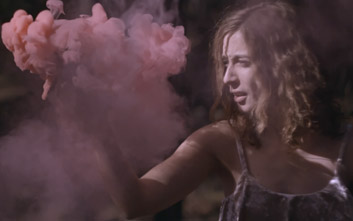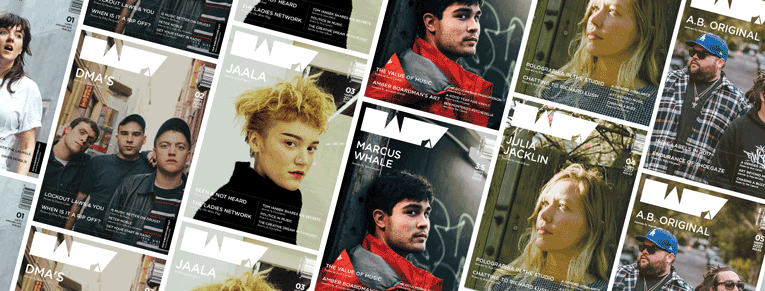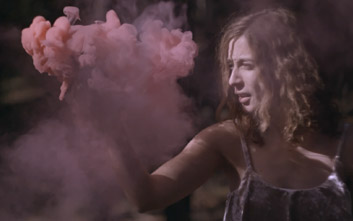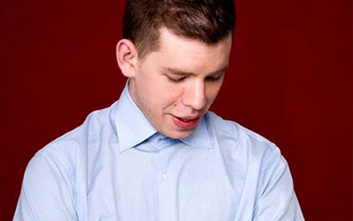A real life production powerhouse led by real life couple Amy Sutton and Kate Tartsus, Lugufi is a company on the upwards bound.
Recently we came across the work of Lugufi in Friends and Family, the spellbinding new clip from Melbourne artist Pikachunes. Wanting to take a closer look behind the scenes, we took five with Amy and Kate to find out a little more about their project.

Reeling in creative aptitude and years of content experience, production company Lugufi is on the verge of absolutely exploding.
HAPPY: Hey there, thanks for taking the time. Can you tell us a little about Lugufi?
KATE: Hi! Thanks for having us. Lugufi (pronounced loo-goo-figh) is a video content and storytelling company led by a real life couple, producer Amy Sutton and myself, editor/cinematographer Kate Tartsus. I’m from Estonia, and lugu in Estonian means story.
AMY: The two of us have been officially working together for a couple of years now, but I have always been in the background, while working in architecture. We decided to formalise Lugufi and make it a joint venture to reflect how we both have been putting the work in, and to prompt the move to how we want to have a creative lifestyle together.
KATE: As a business, we are turning over on branded documentaries, with aspiration to do more narrative work. We are naturally drawn to tech and not-for-profits, in other words, very purpose-driven organisations, as we feel they have the most powerful stories to tell. We are also developing a feature, for which we’ll be seeking local and international funding.
HAPPY: How did you get started?
AMY: Kate comes from film PR, she’s always been involved in film and communications, and I am an architect, who has always worked in 3D and visual media.
KATE: I met Amy when she was a lead singer of a band called Neon Choir in London. I ended up shooting some of their first music videos. At the time, I had no idea what I was doing as I was just experimenting with lighting and camera, but I pulled it off somehow, and I got Amy to like me. We’ve been working and living together for nearly six years now.
HAPPY: What were a few of your first projects?
AMY: It was a series of branded content for ACSO, Australian Community Support Organisation – one of our favourite clients. They help Australians upon their release from custody to re-integrate back into the community, and we produced a 2D animation for their stakeholders as well as a range of live action videos. Last year we produced a short film called Burglary that shortlisted in two categories – Best Sound Design and Best Female Filmmaker in My RØDE Reel competition. We made it into top eight in two categories out of 1224 submissions.
KATE: Apart from producing heaps of branded content, since moving to Australia, I DP-ed a couple of music videos for Australian bands like Dreamcoat (music video for Ghost Legs directed by Cesar Rodrigues) and The Outdoor Type (When the Sun Goes Down). And we’ve got a new one in the works for wonderful Ruby Gill, who just moved here from South Africa. It’s very exciting. I also worked in camera department on a range of feature length and short films, shadowing an amazing cinematographer Matt Scott. I learned a lot from him and I think his style of filmmaking left its mark on the way I approach cinematography.
HAPPY: There’s video content popping up everywhere at the moment. How does Lugufi stay ahead of the crowd?
KATE: We’re in a bit of a lucky position here as we draw on our past professional experiences, specifically in PR and architecture. I still freelance as a video producer and animator for communications and PR agencies and it helps us stay plugged in and keep abreast of what’s happening in the digital landscape. Amy’s experience in 3D is also incredibly invaluable to us as a business, as it opens a whole new level of detailed pre-production possibilities, like project management technique but also specifically 3D pre-visualisation and pre-lighting. 3D pre-vis is a lot more powerful than your basic lighting/blocking schematics, and it can save a lot of time and money on set. We use software that is traditionally reserved for architecture to inform a lot of lighting, set building and blocking decisions.
HAPPY: You’ve recently worked with Pikachunes on Friends and Family. What made you want to work with Miles?
AMY: For me it was all about the song. We had a selection of artists with their selection of songs put in front of us. At that point, we’d already had an idea for a music video and we wanted to make this story. We needed to find music that would suit it. The process was kind of back to front to your typical music video process.
KATE: Yep, we had an idea first. It’s been brewing in my head for many years. This whole asphyxiation game thing is something we used to play as kids. I look back, and it’s so fucking dangerous, it’s unbelievable! It’s also why in this video the asphyxiation part is not exactly sexual, as it is based on my memory of how we played it when we were kids.
AMY: So, we were listening to all these tracks. And not just listening but also looking at how our story idea would work with the artist’s branding, who they are and how they like to position themselves. Miles has got that dark edge, and that was quite attractive, because you knew you can do something a bit twisty and fucked up with it. Friends and Family fit the themes that we were going for. As you covered in your article, we were not following the lyrical storyline that Miles is telling, but the themes of cowardice and disappointment in yourself match, so the musical and visual mediums intertwine and work together.
HAPPY: How does Lugufi go about getting from concept to final product? Everyone seems to have their own method.
AMY: We spend a long time in pre-production. It’s one of these things you must budget carefully and build into your business model, but essentially, we sit down and try and work from a number of storytelling pillars. And even though narrative work is different to branded content, the storytelling concepts remain the same.
KATE: In a nutshell, we look at our key characters, what they want, their deepest burning desires and what’s stopping them from getting what they want. We strive to build strong conflicts, we select important events that can turn the story in a meaningful way, and ultimately, we look at human condition and what it means to be human, often with a lot of darkness. From this point it’s full steam ahead, often with the help of creative partners and collaborators. Pikachunes’ music video was produced in collaboration with Spreading Wings – our long term creative partner and technical producer.
AMY: We use a lot of tools and apps to streamline certain processes like story builder™ for developing and finessing our stories, or frame.io for revisions and sign offs with clients, but ultimately, it often comes down to basic excel sheets. I am the Excel Queen.
KATE: From cinematography standpoint, I often start with location and let the location inform the mood and feel of the story in a natural way. We are also incredibly lucky to have an extensive support network of talented filmmakers who come in at different stages of production. We welcome ideas of other collaborators, to ensure we tell the best story we can.

HAPPY: Were there any behind the scenes challenges you had to overcome?
AMY: The biggest challenge on my part was with getting location permits, as we set out to bring in a small production unit, with two generators, lighting, gazebos, tents, etc. We were bounced around quite a bit, trying to just get hold of the right people. What had happened is Kate and Sandeep from Spreading Wings did a location recce, looking for pine forest to achieve that international look, which means no fucking gums (which is hard in Australia), and they found a spot in Mt Macedon. And so I called the Department of Environment, and I went through the whole process. They were incredibly helpful, but in the end it turned out they didn’t own the land. We found out who did, I contacted them and then it was the wrong people again. Time pressure built up from being bounced around, and we couldn’t realistically move the production dates – any earlier and fire restrictions would mean not being able to use the smoke grenades and any later the chances of rain and high winds would make using the drones unfeasible. Then, two weeks out, we finally get permission to film, but with a surprise bill for a couple of grand instead of a few hundred! We were self-funding this video, so this bill could have been the point to pack your shit and go home really, and we would have lost money on the accommodation and messed around an entire team of cast and crew who’d already committed to the production. But I picked up the phone, and basically pleaded with the location owner to waive the fee. Boom. I’ve not sweated so much in a while.

HAPPY: How do you find working on a music video as opposed to other productions? What do you enjoy more? What do you enjoy less?
KATE: Music videos are a training ground for a lot of filmmakers, and they are just so much fun. You have a lot more of creative control, and it’s an opportunity to work with new people and try out new techniques. They are often labour of love and because of that it’s incredibly satisfying.
AMY: There’s this sentiment among many filmmakers that music videos shape you as an artist, and it’s so true. Off the back of producing this music video for Pikachunes, we decided to call on other filmmakers who recently produced music videos and put on a showcase night called MAED DIS to spread the love and connect with others.
HAPPY: Who are some filmmakers you look up to?
KATE: From cinematography perspective I love Matt Workman and his 3D pre-vis approach to photography. Patrick Sullivan and his journey from one career to becoming a commercial cinematographer is an inspiration. Reed Morano is a powerhouse, both as a DP and as a director. Our London friend and colleague Joe Connor (directed for Coldplay, The Maccabees, Elbow, Placebo), is doing some incredible stuff.
AMY: From Aussie filmmakers we love Oh Yeah Wow and LateNite films, and we feel connected to the Storyboxes, who share the unique stories of remarkable individuals. I love the idea of telling stories that contribute to this kind of organic bank of content that’s going to give future generations insight into the culture of our time, in a way that we just don’t have with previous generations because access to the technology to record their stories was so much more prohibitive than it is now.
HAPPY: What do you hope to see Lugufi doing more of in the future?
AMY: We are chipping away at our first feature, which we’ll be looking to produce in the next couple of years. We will continue working with local and international musicians and purposeful brands, while injecting powerful storytelling techniques into everything we do.




